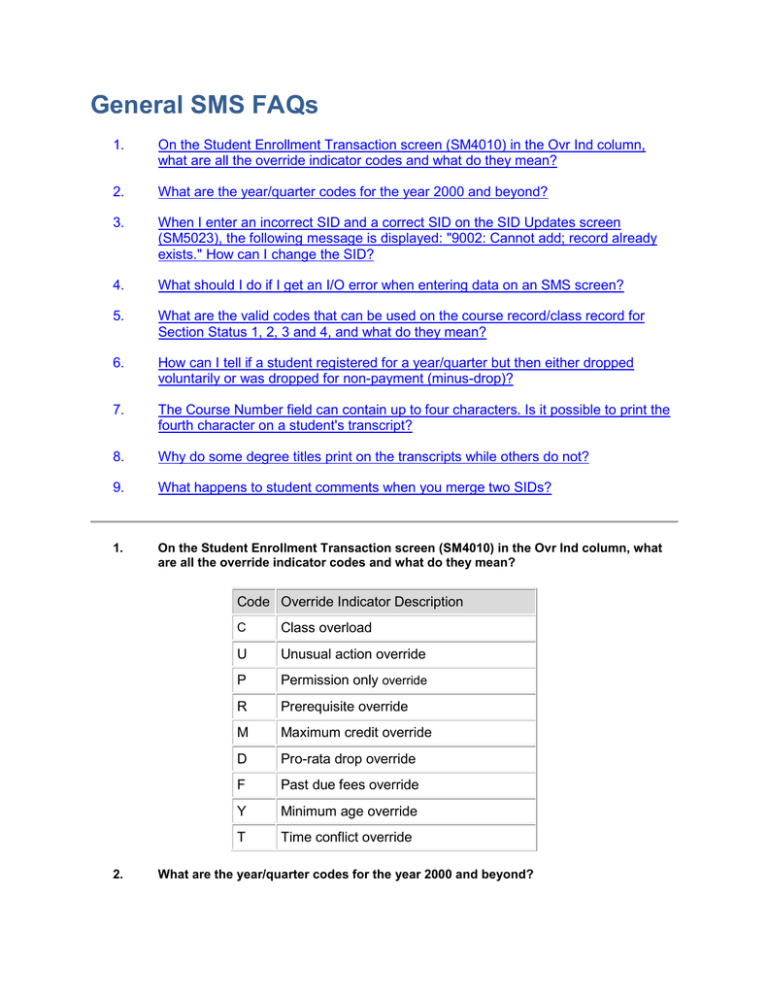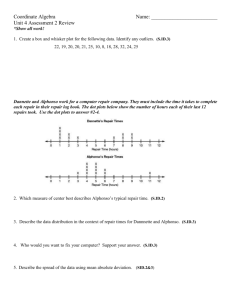General SMS FAQs
advertisement

General SMS FAQs 1. On the Student Enrollment Transaction screen (SM4010) in the Ovr Ind column, what are all the override indicator codes and what do they mean? 2. What are the year/quarter codes for the year 2000 and beyond? 3. When I enter an incorrect SID and a correct SID on the SID Updates screen (SM5023), the following message is displayed: "9002: Cannot add; record already exists." How can I change the SID? 4. What should I do if I get an I/O error when entering data on an SMS screen? 5. What are the valid codes that can be used on the course record/class record for Section Status 1, 2, 3 and 4, and what do they mean? 6. How can I tell if a student registered for a year/quarter but then either dropped voluntarily or was dropped for non-payment (minus-drop)? 7. The Course Number field can contain up to four characters. Is it possible to print the fourth character on a student's transcript? 8. Why do some degree titles print on the transcripts while others do not? 9. What happens to student comments when you merge two SIDs? 1. On the Student Enrollment Transaction screen (SM4010) in the Ovr Ind column, what are all the override indicator codes and what do they mean? Code Override Indicator Description 2. C Class overload U Unusual action override P Permission only override R Prerequisite override M Maximum credit override D Pro-rata drop override F Past due fees override Y Minimum age override T Time conflict override What are the year/quarter codes for the year 2000 and beyond? For year quarter/codes and more detailed information, see Year/Quarter Codes. 3. When I enter an incorrect SID and a correct SID on the SID Updates screen (SM5023), the following message is displayed: "9002: Cannot add; record already exists." How can I change the SID? If a Student Identification Number has been changed from one number back to the original number, SMS will block an additional change of the original number. To process an additional SID change, you need to delete the original changes. Example: On March 1, the SID 000-00-0001 is changed to 000-00-0002. On March 10, the SID 000-00-0002 is changed back to 000-00-0001. On March 20, the SID 000-00-0001 needs to be changed to 000-00-0099. 1. On the SID Updates screen (SM5023), type the original SID (000-00-0001 in the example) in the Incorrect SID field. Press the Enter key. A record is displayed with a joint key of 000-00-0001 and 000-00-0002. Note: To delete this record, you must have access level 2 or 3. 2. Verify that this is a processed SID change. 3. Press F5 (Delete). To complete the delete, press F5 (Delete) again. 4. In the Incorrect SID field, type the original SID (000-00-0001 in the example). In the Correct SID field, type the new SID (000-00-0099 in the example). 5. Press F1 (Add). 6. In the Upd Ind fields, type the correct update indicators. Then press the Enter key. The SID will be changed the next time the job SM5205J (Change On-Line SID Update Job) runs. 4. What should I do if I get an I/O error when entering data on an SMS screen? Occasionally, the following error message may be displayed at the bottom of a screen when you are entering data: 9021: Call Data Center - I/O Error on:(name of data set or process) What does the error message mean? I/O (input/output) errors usually occur when the storage location for the data you are entering has reached its current capacity. Occasionally, there may be communication line problems that cause this error. How do I fix it? This error message will not go away on its own. You must contact SBCTC-ITD Customer Support at (425) 803-9721 to correct the problem. If a data storage location is full, a SBCTC-ITD analyst will initiate a process to increase the location's capacity. This process may require exclusive access to the storage location, in which case it must occur overnight. When you call SBCTC-ITD Customer Support, please provide the following information: • • • • 5. The process ID of the screen displaying the error message, for example, SM5021. The exact wording of the entire error message. The total number of additional records you are planning to create. For example, you might be planning to add 20 new unusual action codes to the Unusual Action Code Table (SM5021). Anything unusual happening with your HP3000 system, for example, communication line problems, extremely slow response time, locked terminals, and so on. What are the valid codes that can be used on the course record/class record for Section Status 1, 2, 3 and 4, and what do they mean? Section Status codes identify processing options unique to specific courses. Valid codes for Section Status 1 (the first bucket for the field) are: P Permission only. V Report the credits on MIS1 as 0; report the credits on MIS2 as XXX. W Compute the credit equivalent from the contact hours. X Cancelled class. Y No registration allowed in this class. Z Don't report the class on the MIS1 or MIS2. Valid codes for Section Status 2 (the second bucket for the field) are: A Exclude from grading C Non-lecture class: no grading D Non-lecture class: graded Valid codes for Section Status 3 (the third bucket for the field) are: F Don't print roster for this class. G Don't print grade mailers for this class. H Don't print roster for this class; don't print mailers for this class. Valid codes for Section Status 4 (the fourth bucket for the field) are: 6. L Don't include the credit amount in total credits registered. M Don't include in printed schedule. N Don't include the credit amount in total credits registered; don't include in printed schedule. Q Don't include in touch-tone class list function or student statement. R Don't include in touch-tone class list function or student statement; don't include credit amount in total credits registered. S Don't include in touch-tone class list function or student statement; don't include in printed schedule. T Don't include in touch-tone class list function or student statement; don't include credit amount in total credits registered; don't include in printed schedule. How can I tell if a student registered for a year/quarter but then either dropped voluntarily or was dropped for non-payment (minus-drop)? The data element STU-QTR-STAT in the STU-YRQ-M database will give you this information about a student. There is no screen where you can view this data element. However, you can use either DataExpress or the SMS Generalized Extract (SM5204J) in job scheduling to extract these students using the data element STUQTR-STAT. Valid codes for STU-QTR-STAT are: 7. A The student still has enrollment records (classes) for the year/quarter. W The student has withdrawn from all classes (W grade-drop) for the year/quarter. X The student no longer has any enrollment records (minus-drop) for the year/quarter. The Course Number field can contain up to four characters. Is it possible to print the fourth character on a student's transcript? You can specify that either the first three characters or all four characters of the course number be printed on a student's transcript. You select this option with your entry in the Tran Course Num (Transcript Course Number Print) field on the Grade Processing Options Screen (SM6003). The valid entries for the Tran Course Num field are: 3 Print the first three characters of the course number. 4 Print all four characters of the course number. 8. Why do some degree titles print on the transcripts while others do not? In order for the degree titles to print on either the official or unofficial transcript, the College Parameter Table (SM5025) must be updated. The parameters SM1089 (unofficial transcript) or SM1090 (official transcript) must be updated to include the exit codes of those degree titles you want to print on the transcript. Any new exit codes must be added to these parameters before the degree titles will print on the transcripts. Detailed information about how to add exit codes can be obtained by going to the SMS College Parameter documentation found in the SMS Documentation Index. 9. What happens to student comments when you merge two SIDs? If the SIDs being merged have overlapping comment YRQs (both records have a comment for the same YRQ), then the comments for the correct SID are used. The incorrect SID comments go away. If the SIDs being merged have comment YRQs that do not overlap, then both comments are copied to the correct SID record.



